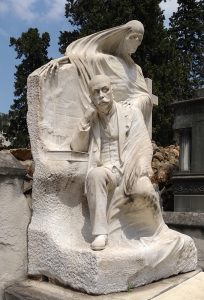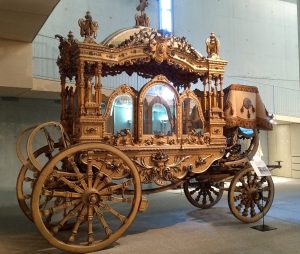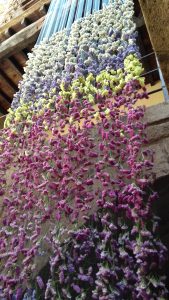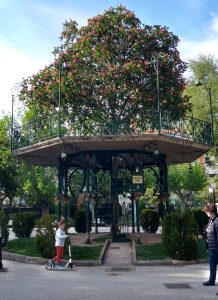Montjuïc Cemetery is a hidden gem on the sea side of Montjuiïc, the hill overlooking Barcelona. It is just loaded with interesting places to visit – a castle, gardens, art galleries, and Olympic venues from the 1992 Olympics. We have visited many of these places, but this time it was to visit the cemetery.

The cemeteries that we have seen in Spain are very different from American cemeteries. Most of the graves are niches that are stacked so high a ladder is needed to read the inscriptions of the top graves. All the graves appear to be above ground. Some of them are covered by big piles of stones that are mortared together. This cemetery is like a little city. There are maps printed with different tour routes – the artistic, historical and the combined routes. It has some beautiful examples of “Modernisme“architecture on the graves and mausoleums.
A highlight of the cemetery is the museum of funeral carriages. They claim to have the first and only display of funeral carriages in Europe. We learned that white carriages were used for children, young women and nuns. In the mid 19th century 34% of deaths among the wealthy classes were children and among the artisan classes it was even higher at 54%. So there was quite a proliferation of these white carriages. They were very beautiful!
Now for something more upbeat! We spent Mother’s Day visiting the spring flower festival in Girona with our friend Gisela. There were some very creative displays of flowers. It was a lovely afternoon wandering around Girona’s old town.
In mid-May, Roy’s sister Penny and her husband Jeff arrived for a visit. We had a lovely time showing them some of our favorite sites in Barcelona such as the Picasso Museum, Mount Tibidabo, and Parc de la Ciutadella. Then a few days road tripping where we got to see field after field of poppies in full bloom! The first night we stopped in Soria, a medium sized city in north central Spain. The museum we wanted to visit was just closing so we walked around the city park and discovered the “music tree”. It was a tree with a bandstand built around it. There was a spiral staircase leading up to a platform where the musicians perform. All I could think about was how difficult it must be for the tubists to get their instruments up there!

The next day we drove to Vitoria-Gasteiz, the capital of Basque country. We made a few stops along the way -a restaurant/olive oil mill where we found “olive butter”, a beautiful canyon, the Mirador Del Cañón Del Rio Leza, the city of Logroño, and Laguardia where we had a wonderful lunch. Our hotel in Vitoria-Gasteiz overlooked a big city park. The horse chestnut trees were in full bloom and provided a spectacular sight out our room windows!

Our return trip took us through Zaragoza where we stopped for lunch. Zaragoza’s history goes back to the ancient Iberians. It was known as Caesaraugusta during Roman times and you can still see evidence of their occupation.
The last stop before returning the car was Sitges. This was a fun place to end this road trip. It is a gorgeous little city on the coast southwest of Barcelona with the most picturesque beach!
What amazing sights!